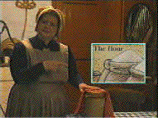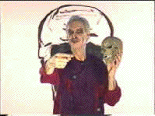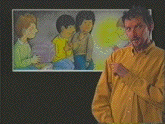| Video and television are visual media. Viewers expect to see more than a 'talking head', or in the case of signing books: 'a signing body'.
In signing books, visuals - still pictures or film - can be used: 1. To support the message and the content of a video, 2. to add visual interest and variety and to support the mood and the pace of a production, and 3. for navigation purposes. The first function is very important for viewers who are not fluent signers, for viewers who are not very familiar with watching sign language on video, and for videos with difficult and/or unfamiliar content. The other functions are important also because they add a 'professional' touch to a production - but they should never be allowed to interfere with the signer, the sign language, and the content of a production. |
In almost all signing books, the sign language is 'illustrated' with still pictures, or film. This is especially important when viewers are not fluent in sign language, when viewers are not used to seeing sign language on video or television, and when the content is unfamiliar or difficult.
Visuals can be pictures of persons, objects, settings, actions.
Visuals can support the 'mood' of a video - as a visual alternative for background music in mainstream videos.
Visuals can be used also, to 'pace' a video, e.g. to indicate the end of a paragraph or chapter. Fast changing visuals, or a rapid alternation of signer and visuals, can make a signing book less 'boring' for young people, and more like mainstream video and television programmes.
Many signing books use 'book-like' illustrations as visuals. In many cases, these visuals were copied from a printed mainstream book or publication; in some cases, the visuals were made especially for the video.
If still pictures are used, they should meet the following criteria:
Film can be either an existing mainstream television programme or video (fiction or non-fiction), or it can be role-play, drama, or a documentary specifically made for this production. The advantage of specifically made materials is that one can use signing actors; the advantage of using pre-existing materials is that these have usually been made with much larger budgets.
Visuals can be used as 'background' to the sign language, without any interaction between the signer and the visuals. This doesn't necessarily mean that the visuals are actually shown behind the signer - there are many other alternatives (see chapter 13 on editing).
A signer may on the other hand interact with the visuals: he may look at them, turn towards them, point to them, or even: manipulate them. This can be done in real life, in front of the camera, or added during the editing phase, by means of superimposing images.
If a signer is to interact with images that will be superimposed during the editing, the interaction should be described carefully in the script.
If existing pictures or video material is to be used, make sure that you are not in violation of copyright laws when you use these. Unless pictures or videos are copyright free, you will need written permission by the publisher and/or the artist of the originals - even if the original production was never published in your country.
For low-vision viewers, it is important that:
 |
 |
 |
| Visuals to support the message. Little Red Hen, Chase Video, GB | Visuals to support the mood. Griezelen, OV-Amsterdam, NL | Interaction with the visuals. Pirate Adventure, Chase Video, GB |